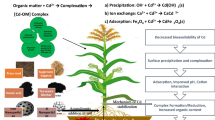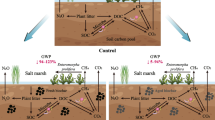Abstract
The purpose of this study is to determine whether the allelopathy of living Myriophyllum aquaticum and its straw has the same effects; two pot experiments were conducted to study the effects of intercropping using M. aquaticum and its straw on the growth and cadmium (Cd) accumulation of Nasturtium officinale. Different planting ratios (1:3, 2:2 and 3:1) of N. officinale and M. aquaticum led to an increase in the biomass of both plant species and increased the Cd content in roots and shoots of N. officinale, but led to a reduction in the Cd content in roots and shoots of M. aquaticum. When the intercropping ratio of N. officinale and M. aquaticum was 3:1, the Cd amount in whole plants reached the maximum of 293.96 μg pot−1. Mulching the straw of M. aquaticum roots on the soil surface increased the biomass of N. officinale, but mulching the straw of M. aquaticum stems and leaves led to a decrease. Mulching the straw of roots, stems and leaves of M. aquaticum reduced Cd content and amounts in roots and shoots of N. officinale. Intercropping with M. aquaticum can improve the Cd uptake ability of N. officinale, but mulching M. aquaticum straw can reduce its Cd uptake ability.
Similar content being viewed by others
References
Ali H, Khan E, Sajad MA (2013) Phytoremediation of heavy metals-Concepts and applications. Chemosphere 91:869–881
Bakht J, Shafi M, Jan MJ, Shah Z (2009) Influence of crop residue management, cropping system and N fertilizer on soil N and C dynamics and sustainable wheat (Triticum aestivum L.) production. Soil Tillage Res 104:233–240
Bao SD (2000) Soil agrochemical analysis. China Agriculture Press, Beijing
Bertness MD, Callaway RM (1994) Positive interactions in communities. Trends Ecol Evol 9:191–193
Brooker RW (2006) Interactions and environmental change. New Phytol 171:271–284
Callaway RM, Brooker RW, Choler P, Kikvidze Z, Lortie CJ, Michalet R, Paolini L, Pugnaire FI, Newingham B, Aschehoug ET, Armas C, Kikodze D, Cook BJ (2002) Positive interactions among alpine plants increase with stress. Nature 417:844–848
Chen LJ, Feng HF, Zhu XM, Liu J, Lin LJ, Liang H, Lan HJ, Liu Q (2014) Effect of Cu and Zn compound pollution on antioxidant enzyme activity of Cu-enrichment plant Myriophyllum aquaticum. Acta Botan Boreali-Occiden Sin 34:2056–2062
Crain CM, Bertness MD (2001) Ecosystem engineering across environmental gradients: implications for conservation and management. Bioscience 56:211–218
Duman F, Leblebici Z, Aksoy A (2009) Growth and bioaccumulation characteristics of watercress (Nasturtium officinale R. BR.) exposed to cadmium, cobalt and chromium. Chem Speciat Bioavailab 21:257–265
Edmondson J (2006) Flora of China 8: Brassicaceae through Saxifragaceae. Bot J Linn Soc 152:132–132
Eriksen J (2006) Gross sulphur mineralisation-immobilisation turnover in soil amended with plant residues. Soil Biol Biochem 37:2216–2224
Gounden D, Kisten K, Moodley R, Shaik S, Jonnalagadda SB (2016) Impact of spiked concentrations of Cd, Pb, As and Zn in growth medium on elemental uptake of Nasturtium officinale (watercress). J Environ Sci Health B 51:1–7
Hadas A, Kautsky L, Goek M, Kara EE (2004) Rates of decomposition of plant residues and available nitrogen in soil, related to residue composition through simulation of carbon and nitrogen tumover. Soil Biol Biochem 36:255–266
Jensen LS, Salo T, Palmason F, Breland TA, Henriksen TM, Stenberg B, Pedersen A, Lundström C, Esala M (2005) Influence of biochemical quality on C and N mineralization from a broad variety of plant materials in soil. Plant Soil 273:307–326
Jiang CA, Wu QT, Wu SH, Long XX (2009) Effect of co-cropping Sedum alfredii with different plants on metal uptake. China Environ Sci 29:985–990
Li CJ, Ma W, Zhang FS (2008) Rhizosphere talk and its impacts on plant growth. Plant Nutr Fertil Sci 14:178–183
Li XB, Xie JZ, Li BW, Wang W (2009a) Ecological responses of Brassica Juncea intercropping to cadmium stress. Chin J Appl Ecol 20:1711–1715
Li YB, Liu JG, Cheng XR, Zhang W, Sun YY (2009b) The allelopathic effects of returning cotton stalk to soil on the growth of succeeding cotton. Acta Ecol Sin 29:4942–4948
Lin L, Liao M, Ren Y, Luo L, Zhang X, Yang D, He J (2014) Effects of mulching tolerant plant straw on soil surface on growth and cadmium accumulation of Galinsoga parviflora. PLoS One 9:e114957
Lin LJ, Luo L, Liao MA, Zhang X, Yang DY (2015) Cadmium accumulation characteristics of emerged plant Nasturtium officinale R. BR Res Environ Yangtze Basin 24:684–689
Ma TZ, Ma YH, Xu LL, Fu HH, Nie JR (2013) Agro-ecological remediation technologies on heavy metal contamination in cropland soils. J Agric Res Environ 30:39–43
Malik RN, Husain SZ, Nazir I (2010) Heavy metal contamination and accumulation in soil and wild plant species from industrial area of Islamabad, Pakistan. Pak J Bot 42:291–301
Mcgrath SP, Zhao FJ, Lombi E (2001) Plant and rhizosphere processes involved in phytoremediation of metal-contaminated soils. Plant Soil 232:207–214
Milojković J, Pezo L, Stojanović M, Mihajlović M, Lopičić Z, Petrović J, Stanojević M, Kragović M (2016) Selected heavy metal biosorption by compost of Myriophyllum spicatum—a chemometric approach. Ecol Eng 93:112–119
Nie FH (2005) New comprehensions of hyperaccumulator. Ecol Environ Sci 14:136–138
Padilla FM, Pugnaire FI (2006) The role of nurse plants in the restoration of degraded environments. Front Ecol Environ 4:196–202
Padmavathiamma PK, Li LY (2007) Phytoremediation technology: hyperaccumulation metals in plants. Water Air Soil Pollut 184:105–126
Pan Y, Zhou LX (2007) Influence of applying organic manures on the chemical form of Cu and Cd in the contaminated soil and on wheat uptake: field micro-plot trials. J Nanjing Agric Univ 30:142–146
Pugnaire FI, Luque MT (2001) Changes in plant interactions along a gradient of environmental stress. Oikos 93:42–49
Ramamurthy AS, Memarian R (2012) Phytoremediation of mixed soil contaminants. Water Air Soil Pollut 223:511–518
Rastmanesh F, Moore F, Keshavarzi B (2010) Speciation and phytoavailability of heavy metals in contaminated soils in Sarcheshmeh area, Kerman province, Iran. Bull Environ Contam Toxicol 85:515–519
Sarma H (2011) Metal hyperaccumulation in plants: a review focusing on phytoremediation technology. J Environ Sci Technol 4:118–138
Shan H, Li ST, Liu RL (2009) Availability and the related mechanisms of cadmium in soils as influenced by the application of straw or pig manure. J Nucl AgricSci 23:139–144
Sun H, Tan CY, Huang DY, Wan DJ, Liu LK, Yang Y, Yu X (2011) Effects of soil organic matter on the accumulation, availability and chemical speciation of heavy metal. J Nat Sci Hunan Normal Univ 34:82–87
Tang FY, Lin LJ, Liao MA, He J, Yang DY, Zhang X (2015) Effects of applying accumulator straw in soil on growth and cadmium accumulation of Galinsoga parviflora. Acta Agriculturae Boreali-Sinica 30:213–218
Tong YP, Kneer R, Zhu YG (2004) Vacuolar compartmentalization: a second-generation approach to engineering plants for phytoremediation. Trends Plant Sci 9:7–9
Van Aken B (2009) Transgenic plants for enhanced phytoremediation of toxic explosives. Curr Opin Biotechnol 20:231–236
Wang F, Wang W (2008) Review of development and utilization of straw resources in China. Resour Dev Market 24:1009–1012
Wenzel WW (2009) Rhizosphere processes and management in plant-assisted bioremediation (phytoremediation) of soils. Plant Soil 321:385–408
Whiting SN, Leake JR, Mcgrath SP, Baker AJ (2001) Hyperaccumulation of Zn by Thlaspi caerulescens can ameliorate Zn toxicity in the rhizosphere of cocropssped Thlaspi arvense. Environ Sci Technol 35:3237–3241
Xiang YC, Guan CY, Huang H, Peng XH (2010) Effects of intercropping on accumulation of Cd and Pb in oilseed rape. J Soil Water Conserv 24:50–55
Xue LL, Shakeel AA, Liu XJ, Zou CM, Hu XD, Zhang YL, Wang LC (2011) Effect of straw mulch conservative cultivation on growth, yield and soil nutrients of rapeseed (Brassica compestris). J Agric Mechanization Res 33:110–115
Yabanli M, Yozukmaz A, Sel F (2014) Heavy metal accumulation in the leaves, stem and root of the invasive submerged macrophyte Myriophyllum spicatum L. (Haloragaceae): an example of Kadin Creek (Mugla, Turkey). Braz Arch Biol Technol 57:434–440
Zhang XF, Xia HP, Li ZA, Zhuang P, Gao B (2011) Identification of a new potential Cd-hyperaccumulator Solanum photeinocarpum by soil seed bank-metal concentration gradient method. J Hazard Mater 189:414–419
Zhao MM, Jiang M, Zhou ZW (2011) The components analysis of several kinds of agricultural residues. Mater Rev (B) 25:122–125
Zhu JW, Zou DS, Xiang YC, Wang H, Tan WW (2012) Effects of straw addition on physiological parameters and uptake of heavy metals in Ricinus communis under the stress of Pb/Zn mine tailing. J Hunan Agric Univ (Nat Sci) 38:325–329
Author information
Authors and Affiliations
Corresponding author
Additional information
Responsible editor: Elena Maestri
Rights and permissions
About this article
Cite this article
Huang, K., Lin, L., Chen, F. et al. Effects of live Myriophyllum aquaticum and its straw on cadmium accumulation in Nasturtium officinale . Environ Sci Pollut Res 24, 22503–22509 (2017). https://doi.org/10.1007/s11356-017-9928-y
Received:
Accepted:
Published:
Issue Date:
DOI: https://doi.org/10.1007/s11356-017-9928-y




